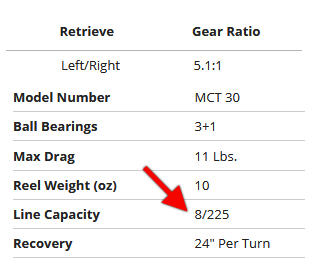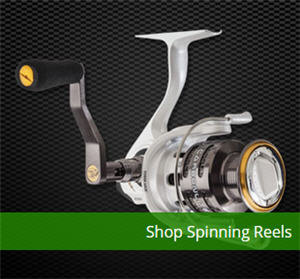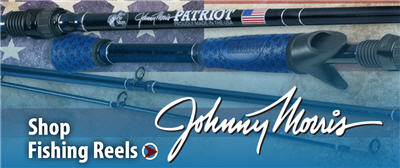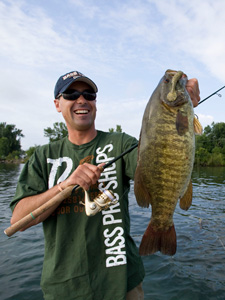
For many anglers, fishing with spinning reels have surpassed baitcaster reels as the fishing reel of choice, probably because spinning reels are easy to use and don't have the learning curve of casting reels. Also, for light-line applications and finesse techniques, spinning reels reign supreme in terms of performance and ease of use. Choosing the best spinning reel for your needs, however, can often be challenging if you're unfamiliar with how a spinning reel operates and the terms used to discuss reel performance. Take a read through the following guide to pick up some helpful hints for choosing the perfect spinning reel.
 The Parts of a Spinning Reel
The Parts of a Spinning Reel
Many anglers refer to spinning reels as open-face reels. Another unique feature of a spinning reel is that it is mounted to the underside of a fishing rod. Spinning reels are great fishing reels for beginning anglers because of their easy use and due to their design, they are less likely to get tangles in the fishing line. This reel type has eight main parts, they are: The reel foot, reel handle, reel body, anti-reverse switch, the bail, line spool, spool release and drag adjustment and line roller.
Spinning Reel Body & Weight
Reel bodies (often referred as the "housing") can be made of graphite or aluminum, or sometimes a combination of both. Aluminum housing is stronger than graphite and exhibits less flex; however, graphite is lighter. Deciding whether strength or weight is more important is ultimately a personal choice. The highest quality freshwater reels tend have aluminum bodies; however, if your chosen playing field is saltwater, graphite is the way to go due to its corrosion-resistant qualities.
 |
| Bass Pro Shops MegaCast Spinning Reel - MCT10 |
Another factor to look for is a solidly constructed reel body. There should be no loose or flimsy parts, and all moving parts should be smooth in performance and have no back play whatsoever. Also, spinning reels have more parts than casting reels. Choosing a reel with fewer parts can reduce the chances of mechanical breakdown.
Weight is another key factor when deciding on a reel for one simple reason — fatigue. Less strain is put on the wrist and forearm when dealing with a lighter reel, and for those that spend a great deal of time on the water, this can be even more important in terms of joint stress and fatigue. Most reels will give weight in ounces. Make weight a consideration when shopping for a spinning reel, and when comparing reel weights online, be sure you're comparing similar sized reels.
Pick the Correct Spinning Reel Size
Choosing the correct reel size is as easy as determining the size fishing line you intend to use most often. The lighter the line you intend to use, the smaller the reel you should purchase. Ten-pound test line should be the highest strength and diameter used on a spinning reel. (This is not applicable for saltwater fishing or heavy trolling scenarios.)
 For example, if you primarily jig for smallmouth bass and walleye, 8-pound test fishing line would probably be your average line strength. Therefore, choosing a medium-size reel rated for 6, 8 and 10-pound line would be your best selection.
For example, if you primarily jig for smallmouth bass and walleye, 8-pound test fishing line would probably be your average line strength. Therefore, choosing a medium-size reel rated for 6, 8 and 10-pound line would be your best selection.
To make sure that the reel you're buying is rated for the pound-test line you intend to use, check the line capacity information found on the spool of the reel, or, if shopping online, in the product chart. The chart typically displays the middle line capacity, so if it says "6 LB/90 YDS," the reel is also well suited for 4 and 8 pound line.
Understand the Reel Gear Ratio
 |
| Fishing reels come in all sizes; make sure you choose a reel that matches the line size you intend to use most often. |
Unlike casting reels, which have a rotating spool, the spool on a spinning reel is fixed, and a bail wraps the line onto the spool as you turn the handle. So when discussing spinning reels, gear ratio refers to the number of times the bail rotates around the spool with a single turn of the reel handle. For example, on a reel with a 4:1 gear ratio, the bail rotates around the spool four times for every one single turn of the handle. A 4:1 gear ratio is considered a slow-speed reel because a relatively small amount of line is "picked up" during the cranking process (four wraps of line around the spool with each crank). The benefit is that these reels provide more torque for reeling in large fish. A 6:1 ratio is considered a high-speed retrieve. A high, low or medium speed retrieve should be determined by the style of fishing you intend to do.
If you can only choose one spinning reel, go for a medium speed model (5:1). However, if you can afford more than one reel, adding a high-speed and low-speed reel to your arsenal will allow you to best cover all situations.
you can only choose one spinning reel, go for a medium speed model (5:1). However, if you can afford more than one reel, adding a high-speed and low-speed reel to your arsenal will allow you to best cover all situations.
"Line recovery" is a measurement in inches that's generally given for spinning reels. This measurement simply states the length of line that is wound onto the spool for each turn of the handle.
Consider the Drag System on a Spinning Reel
The drag system on a spinning reel is another important aspect to consider. The drag is responsible for applying pressure to a hooked fish, and letting out line during the fight. Without a smooth, high-quality drag the risk of broken lines and lost fish is a high probability. Always ensure that the reel you purchase has a smooth, non-constrictive drag. The line should pull out steadily, without hesitation, at whatever tension you set the drag.
 There are two types of drag systems available on spinning reels: front and rear drag. Basically, this refers to the location of the drag controls, but there are some additional differences between the two styles. Front-drag systems generally feature multiple, large drag washers that offer increased durability and performance in comparison to rear-drag models. Rear-drag controls are easier to access (especially when fighting fish) yet they don't stand up as well to large, hard fighting fish species.
There are two types of drag systems available on spinning reels: front and rear drag. Basically, this refers to the location of the drag controls, but there are some additional differences between the two styles. Front-drag systems generally feature multiple, large drag washers that offer increased durability and performance in comparison to rear-drag models. Rear-drag controls are easier to access (especially when fighting fish) yet they don't stand up as well to large, hard fighting fish species.
Refinements are continually made within the fishing reel market, and the advent of sealed drag systems is a very noteworthy innovation. Exposure to elements can compromise the integrity of drag systems and inner gears, leading to drag slippage and mechanical problems over time. These issues are a thing of the past with sealed drag systems, which are available on Johnny Morris Signature Series fishing reel brand, Extreme spinning reels and the Bass Pro Shops Pro Qualifier spinning reels. A waterproof sealed drag system will ensure your spinning reel operates smoothly, with added drag power and durability, for years to come.
 |
| Spinning reels reign supreme for light-line applications and finesse techniques, such as jigging for walleye and smallmouth bass. |
Know About the Ball Bearings in a Spinning Reel
Spinning reels feature ball bearings or bushings placed within the body for smoothness, support and stability. Most spinning reels also contain a roller bearing within the line roller. Generally speaking, the greater number of bearings a reel contains, the smoother the reel will perform. (Sealed stainless steel bearings are preferable over bushings for added durability and control.)
Choose a reel with the most ball bearings that your wallet can handle. At the bare minimum, I would suggest a reel with at least four ball bearings. There's nothing worse than having a reel that doesn't perform well, or isn't smooth on the retrieve, so try not to scrimp and save when it comes to this part of the reel equation — you'll curse yourself all the way back to the launch ramp.
Spools on a Spinning Reel Are Important
 |
| Mag spools like the one on the Johnny Morris Signature Reel (above) are wider and flatter, allowing for longer casts, faster retrieves, reduced line twist and increased line pickup. |
The spool on a spinning reel plays an important part, not only for holding line, but also for casting distance and smoothness. Most spools on the market today are either anodized aluminum or graphite. As mentioned before, graphite is the lighter of the two materials, while aluminum spools offer greater strength and rigidity under pressure.
There are two basic spool styles: internal or skirted. Internal spools are mostly a thing of the past, although some manufacturers still make a few models for die-hard devotees. One major drawback to internal spools is the ease with which line becomes entangled within the housing of the reel. Skirted spools have helped alleviate this frustrating problem, and that's why this style has prevailed.
A variation of the skirted spool, the "long cast" spool features an interesting design with some purported benefits. Much as the name suggests, this spool is shallower than the regular style, although much longer in length. This elongated spool supposedly allows for less line friction, allowing increased casting distance for the angler — a definite benefit for clear-water or sight-fishing applications.
An even newer innovation in spinning reel design, Mag Spool Technology offers many some of the same benefits of the long cast spool, but with a different approach. These enlarged spools are both wider and flatter in composition to regular spinning reel spools. This unique design allows for longer casts, faster retrieves, reduced line twist and increased line pickup with each turn of the handle. Mag spools also reduce the likelihood of "line binding" — a frustrating tangle that tends to occur when using superlines on spinning reels — by "slackening" the line wound onto the reel; the less tight braid is spooled on a reel, the less likely it is to bind during casts or vigorous hooksets.
 |
| Bass Pro Shops Pro Qualifier Spinning Reel |
Mag Spool Technology is available on select Bass Pro Shops' spinning reels, including the Johnny Morris Signature Series and Pro Qualifier spinning reels.
Anti-Reverse Handles on a Fishing Reel
Anti-reverse handles are a prerequisite when searching for that perfect spinning reel. This function prevents the handle from spinning backward so that hook sets are powerful and accurate. If the spinning reel you're looking at has any sort of backward motion, my advice would be to look for a different model — your landing net will thank you.
While on the topic of handles, ensure that the reel you choose has a substantial arm and knob. A larger stature enables the angler to quickly "find" the handle, and also allows a firmer grip with less chance for slippage during wet weather, or when hands are sweaty.
Choosing a spinning reel may seem like a tough decision, however, learning some of the traits and beneficial components can shorten the learning curve dramatically. Purchase the best reel that you can afford, and it will be your best friend out on the water for many years to come. Choose wisely and it won't let you down.
- 238291 views


